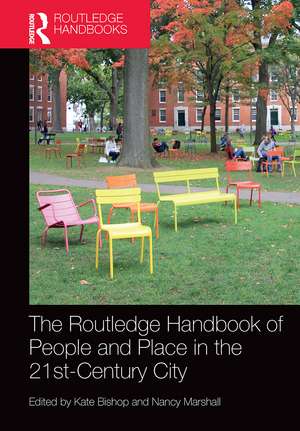The Routledge Handbook of People and Place in the 21st-Century City
Editat de Kate Bishop, Nancy Marshallen Limba Engleză Paperback – 29 aug 2022
This book contains an interdisciplinary discussion of contemporary urban movements and issues influencing the relationship between people and place in urban environments around the world which have major implications for both the processes and products of urban planning, design, and management. The main purpose of the book is to consolidate contemporary thinking among experts from a range of disciplines including anthropology, environmental psychology, cultural geography, urban design and planning, architecture and landscape architecture, and the arts, on how to conceptualize and promote healthy people and place relationships in the 21st-century city. Within each of the chapters, the authors focus on their specific areas of expertise which enable readers to understand key issues for urban environments, urban populations, and the links between them.
Preț: 302.36 lei
Preț vechi: 342.99 lei
-12% Nou
Puncte Express: 454
Preț estimativ în valută:
57.86€ • 59.26$ • 48.13£
57.86€ • 59.26$ • 48.13£
Carte tipărită la comandă
Livrare economică 19 martie-02 aprilie
Preluare comenzi: 021 569.72.76
Specificații
ISBN-13: 9781032401232
ISBN-10: 1032401230
Pagini: 332
Ilustrații: 62
Dimensiuni: 178 x 254 mm
Greutate: 0.59 kg
Ediția:1
Editura: Taylor & Francis
Colecția Routledge
Locul publicării:Oxford, United Kingdom
ISBN-10: 1032401230
Pagini: 332
Ilustrații: 62
Dimensiuni: 178 x 254 mm
Greutate: 0.59 kg
Ediția:1
Editura: Taylor & Francis
Colecția Routledge
Locul publicării:Oxford, United Kingdom
Public țintă
Professional and UndergraduateCuprins
Introduction: The Power of Cities on People-Place Relationships Section 1: Vibrant Cities Ch 1. Self-conscious and unselfconscious placemaking in the city Ch 2. Using places / exchanging places Ch 3. Festival Bodies: The Role of the Senses and Feelings in Place-Making Practices Ch 4. A Sound Understanding of Healthy Cities Ch 5. Art, communities and housing form: A practitioner’s perspective Section 2: Diverse Cities Ch 6. Pushing diversity beyond recognition Ch 7. Diversity in density: Encouraging participation in higher density living Ch 8. Knowing their place: Children, young people and cities Ch 9. Exercise space planning and design for an aging society: A case study of space, exercise behaviour and cognitive function of older women in Taiwan Ch 10. Culture, citizenship and the practice of place-making Section 3: Equitable Cities Ch 11. The Experience of place and displacement in the 21st century city Ch 12. Propositions for more just urban public spaces Ch 13. Place-based activism: Out of the frying pan of citizen disengagement or into the fire of territorial localism? Ch 14. Morphing paradise ideology, culture and planning in Bali Ch 15. Consuming heritage or the end of tradition: Challenges in the transition from vernacularism to globalization Ch 16. The technological infrastructure of place Ch 17. Socio-ecological dimensions: People, place and technology Ch 18. Overcrowding and domestic use of public space Ch 19. Tel Aviv: Making place through technology Ch 20. Web 2.0 social media: Supporting people-place relationships Section 5: Resilient Cities Ch 21. Place Attachment, well-being and resilience Ch 22. Putting people first in place-based urban post-disaster recovery Ch 23. Rebuilding after disaster: People, processes and five per cent technology Ch 24. Making place by making things again? How artisanal makers are reshaping place in post-industrial Detroit and Newcastle Ch 25. Resilience in a warming climate: Public place-making for health and wellbeing in hot cities Ch 26. Urban Greenspace: Places supporting urban resilience Conclusion: Meeting the demands for change, adaptation and innovation in 21st Century cities
Recenzii
"This handbook is a really remarkable multidisciplinary and international survey of the complex ways in which cities serve as critical arenas for struggles of belonging, social justice and resilience. I also read it as an invaluable guidebook to the diverse, essential yet elusive importance of place and placemaking for resolving these struggles as cities continue to grow and change in unprecedented ways." –Edward Relph, Emeritus Professor, University of Toronto, Canada
Notă biografică
Kate Bishop is a Senior Lecturer in the Faculty of Built Environment at the University of New South Wales (UNSW) in Sydney, Australia. Her background in environment-behavior research underpins her teaching and research, and her particular area of interest is children, youth, and environments. She specializes in the research and design of environments for children with special needs; pediatric facilities; and participatory methodologies with children and young people. Kate worked in the private industry and government before completing her PhD and becoming an academic.
Nancy Marshall is an Associate Professor in the City Planning Program at UNSW in Sydney, Australia, where she was the Associate Dean/Education from 2009 to 2013 and won the UNSW Vice-Chancellor’s Award for Teaching Excellence. Her research focuses on people and place, with a particular focus on plazas, parks, and smart cities. Her recent book is co-authored with Jon Lang and entitled Urban Squares as Places, Links and Displays (2017). Nancy worked as an urban planner in Canada for 15 years before completing her PhD and becoming an academic.
Nancy Marshall is an Associate Professor in the City Planning Program at UNSW in Sydney, Australia, where she was the Associate Dean/Education from 2009 to 2013 and won the UNSW Vice-Chancellor’s Award for Teaching Excellence. Her research focuses on people and place, with a particular focus on plazas, parks, and smart cities. Her recent book is co-authored with Jon Lang and entitled Urban Squares as Places, Links and Displays (2017). Nancy worked as an urban planner in Canada for 15 years before completing her PhD and becoming an academic.
Descriere
This book contains an interdisciplinary discussion of contemporary urban movements and issues influencing the relationship between people and place in urban environments around the world which have major implications for both the processes and products of urban planning and design.
